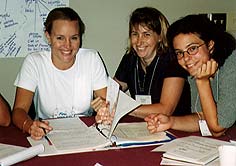|
Archived Content from Conference Held in October 2008
What is language immersion education?
Key Terms and Acronyms
Minority language (MinL)
A language other than the one spoken by the majority of people in a given regional or national context, for example, Spanish in the U.S., Basque in Spain, English in Japan, etc.
Majority language (MajL)
The language spoken by the majority of people in a given regional or national context, for example, English in the U.S., Spanish in Spain, Japanese in Japan, etc.
Immersion Education as Defined in the Literature
Immersion is used by many individuals to describe a set of instructional techniques that correspond to a language teacher’s exclusive use of the target language for instruction. For the purposes of this conference, the term "immersion" refers to a choice-based educational program model that adheres to a core set of essential criteria.
These include:
- Subject matter teaching in a MinL
- At least 50% of the day at the elementary level (PreK or K through Grade 5 or 6)
- 2 or more year-long courses in the MinL in grades 6-12
- Commitment to additive bilingualism and biliteracy
- Teachers who are fully proficient in their language(s) of instruction
- Community support for the MajL for majority language-speaking students and home language support for the MinL for minority language-speaking students
- Clear separation of languages for sustained periods of time
Additional distinguishing features of well-implemented immersion programs are:
- Content-driven and language-attentive curriculum
- Integration of language, culture and content
- Cognitively and linguistically challenging tasks
- Developmentally appropriate instructional scaffolding
- Frequent peer-peer communication and use of MinL
- Structured cooperative learning experiences
The end goals of an immersion education include academic achievement, proficiency and literacy in at least two languages, and enhanced levels of intercultural sensitivity. Program success and long-term viability are measured primarily by immersion students’ academic achievement relative to non-immersion peers on standardized tests administered in the country’s majority language.
Within these parameters, program purpose and student population vary. This conference brings together three main branches:
- Foreign language or “one-way” immersion intended for speakers of the majority language,
- Bilingual or “two-way” immersion for speakers of a minority language and the majority language, and
- Indigenous immersion or “Aboriginal” immersion for Native Peoples.
Other program characteristics also differ such as the grade level at which the program begins, the proportion of instruction in each of the program’s languages, etc. We offer this clarification to assist individuals and institutions interested in this conference to more clearly understand the intended audience.
References
Christian, D. (1996). Two-way immersion education: Students learning through two languages. The Modern Language Journal, 80, 66–76.
Cloud, N., Genesee, F., & Hamayan, E. (2000). Dual Language Instruction: A Handbook for Enriched Education. Boston, MA: Heinle & Heinle.
Fortune, T. W., & Tedick, D. T. (in press). Pathways to Multilingualism: Evolving Perspectives on Immersion Education. Clevedon, United Kingdom: Multilingual Matters Ltd.
Howard, E., Lindholm-Leary, K., Sugarman, J., Christian, D., & Rogers, D. (2005). Guiding Principles for Dual Language Education. Washington, DC: Center for Applied Linguistics.
Lambert, W. E. (1984). An overview of issues in immersion education. In R. Campbell (Ed.), Studies on Immersion Education: A Collection for United States Educators, (pp. 8-30). Sacramento, CA: California State Department of Education.
Lenker, A. & Rhodes, N. (2007). Foreign language immersion programs: Features and trends over 35 years. The ACIE Newsletter, 10(2), 1-8.
Lindholm, K. J. (1990). Bilingual immersion education: Criteria for program development. In A. Padilla, H. Fairchild, and C. Valadez (Eds.), Bilingual Education: Issues and Strategies, (pp. 91–105). Newbury Park, CA: Sage Publications.
Lindholm-Leary, K. (2001). Dual Language Education. Clevedon, United Kingdom: Multilingual Matters Ltd.
Swain, M. & Johnson, R. K. (1997). Immersion education: A category within bilingual education. In R. K. Johnson & M. Swain (Eds.), Immersion Education: International Perspectives, (pp. 1-16). NY: Cambridge University Press.
Torres-Guzmán, M. E., Kleyn, T., Morales-Rodríguez, S. & Han, A. (2005). Self-designated dual-language programs: Is there a gap between labeling and implementation? Bilingual Research Journal, 29(2), 453-474.
Wink, J. (1991). Immersion confusion. TESOL Matters, 1(6), 10.

|




